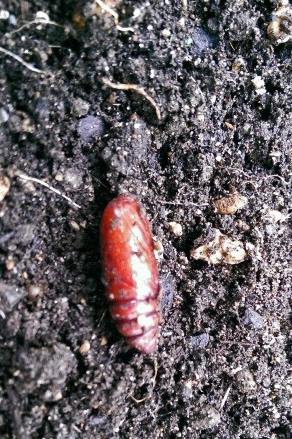While heading outside to do a little weeding on a recent sunny day I decide to check out my currant bushes. Two years ago I planted one bush each of red, white and black currants and I expect this year I’ll have a nice big crop. What the heck!?! The leaves had been chewed on and in some cases only the leaf stem and veins were left!
Upon checking the undersides of the remaining leaves I saw many, many little green worms busily munching their way through breakfast! They looked remarkably like sawfly larvae and, as far as I was concerned, needed to be got rid of immediately.
So what to do? I opted for the ‘squash method’ (I put on my gardening gloves and pinched them) until I was too grossed out to continue. Next, I tried the ‘shake them off and stomp on them’ method until I was too irritated to go on (there were hundreds of worms). Finally, I got out the Captain Jack’s Deadbug spray, which contains Spinosad. That took care of the worms without too much fuss.
As I sprayed both the underside and top of each leaf I pondered the situation: what other pests might be lurking in my garden? I decided to take a wander.
I love my roses - and aphids love them, too. I was pretty sure they’d be enjoying the tender buds and new, leafy growth. Luckily, they’re easy to get rid of. The ‘squash’ method is very effective with a small aphid infestation, and spraying them off with the hose gets rid of larger quantities. I also tap the plant or stem until the aphids fall onto the soil. Did you know that once an aphid hits the ground it won’t be able to get back to the plant and will quickly die?
With a little vigilance you can keep the aphid population to a dull roar until the predators move in and start feasting on them. Lady bird beetles (ladybugs) and parasitic wasps both do an excellent job of keeping the population down, with the voracious lady beetle larvae being the champion. Just don’t kill off these weird-looking lady bug offspring before they turn into the cute little ladybugs that charm us.
I also noticed what looks like spit on some of the roses. I saw this on my irises and campanula too and a quick inspection revealed a tiny insect inside each ball of ‘spit’. These are actually spittlebug nymphs and that ‘spit’ is their protective camouflage. Small populations won’t do much harm and are easily controlled by a sharp spray of the hose to knock them off.
Hmmm, what else might I find lurking in the garden? I knew there are cutworms once I saw the evidence of chewed leaves around the peonies and irises and I was pretty sure if I dug at the base of the Spanish bluebells I’d find a couple there, too – cutworms can chew up the leaves of a plant in no time at all.
Not only did I find the cutworms, but I also found their pupae, which are easily destroyed with a quick snip of the same trusty shears I’ve been using for years to prune my garden.
I find that getting out in the garden and getting rid of the pests in May and June helps prevent major plant damage. The soil is teeming with insects, both good and bad, and knowing what’s a pest and what isn’t makes for much healthier gardens. Besides, what’s the point of growing currants if you can’t harvest them for a traditional English Summer Pudding?
Summer Pudding
This recipe is taken from Delia Smith’s Complete Cookery Course, Delia Smith’s Complete Illustrated Cookery Course and The Evening Standard Cookbook.
"Maybe the reason why this pudding is such a favourite is because we only have these particular fruits for such a short time each year – anyway in our house it's become a sort of annual event. Do try to get a well-made white loaf, though: the texture of sliced white is most unsuitable." ~ Delia
Ingredients
8 oz (225 g) red currants
4 oz (110 g) black currants
1 lb (450 g) raspberries
5 oz (150 g) caster sugar
7-8 medium slices white bread from a large loaf
You will also need a 1½ pint (850 ml) pudding basin (dish), lightly buttered.
Method
Separate the red currants and black currants from their stalks by holding the tip of each stalk firmly between finger and thumb and sliding it between the prongs of a fork pushing the fork downwards, so pulling off the berries as it goes. Rinse all the fruits, picking out any raspberries that look at all musty.
Place the fruits with the sugar in a large saucepan over a medium heat and let them cook for about 3-5 minutes, only until the sugar has dissolved and the juices begin to run – don't overcook and so spoil the fresh flavour. Now remove the fruit from the heat, and line the pudding basin with the slices of bread, overlapping them and sealing well by pressing the edges together. Fill in any gaps with small pieces of bread, so that no juice can get through when you add the fruit.
Pour the fruit and juice in (except for about two thirds of a cupful), then cover the pudding with another slice of bread. Then place a small plate or saucer (one that will fit exactly inside the rim of the bowl) on top, and on top of that place a 3 lb or 4 lb (1.3 kg or 1.8 kg) weight, and leave in the fridge overnight.
Just before serving the pudding, turn it out on to a large serving dish and spoon the reserved juice all over, to soak any bits of bread that still look white. Serve cut into wedges, with a bowl of thick cream on the table.
Note: all uncredited photos by Kathy Boullin





